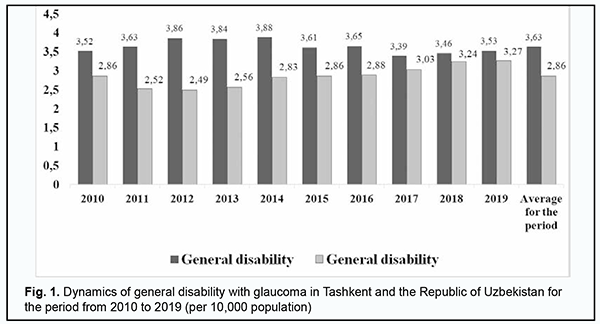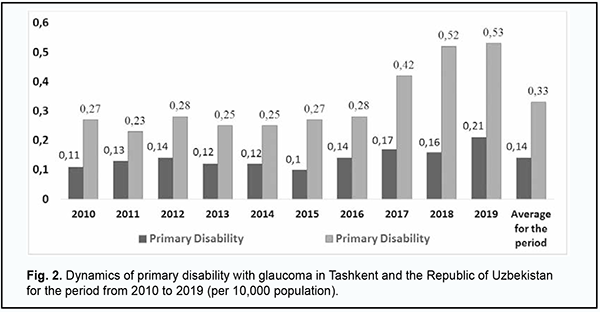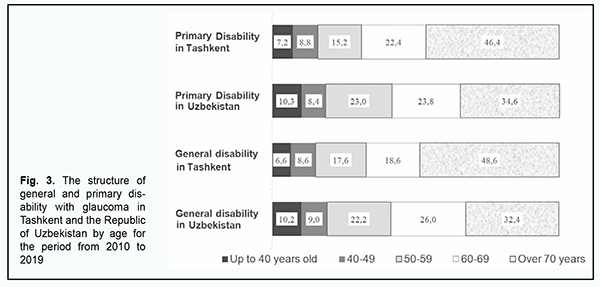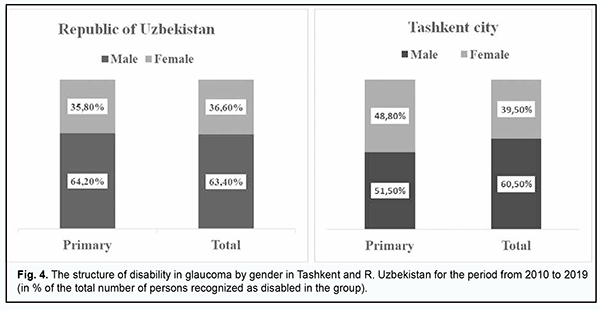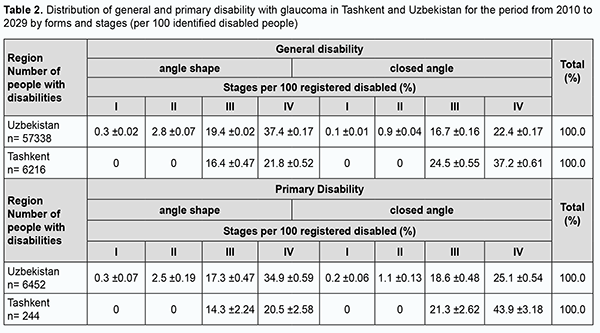J.ophthalmol.(Ukraine).2022;4:12-17.
|
http://doi.org/10.31288/oftalmolzh202241217 Received: 02.07.2022; Published on-line: 24.08.2022 Longitudinal changes in the disability due to glaucoma in Uzbekistan D. M. Tuychibaeva Tashkent State Dental Institute; Tashkent (Uzbekistan) TO CITE THIS ARTICLE: Tuychibaeva DM. Longitudinal changes in the disability due to glaucoma in Uzbekistan. J.ophthalmol.(Ukraine).2022;4:12-17. http://doi.org/10.31288/oftalmolzh202241217
Background. Glaucoma is One of the main causes of disability and blindness in the ICD – X class of Diseases of the eye and its appendage. Purpose. Study of the dynamics of primary and general disability due to glaucoma among the adult population of the Republic of Uzbekistan and Tashkent city for the period from 2010 to 2019. Material and Methods. A retrospective study of the data of the Medical and Social Service Agency under the Ministry of Health of the Republic of Uzbekistan from 2010 to 2019 on the number of disabled people among the adult population diagnosed with glaucoma in the Republic of Uzbekistan and Tashkent was realized. Intensive and extensive indicators, dynamics and structure of general and primary disability were calculated, average period indicators were determined, regressive analysis was accomplished and a forecast of the development of the situation for the coming years was given. Results. For the period from 2010 to 2019 years, 6842 people were recognized as disabled people in Uzbekistan for the first time in the Republic, while 58544 disabled people with this pathology were registered in the country during the study period. Of these, 57338 people (97.9±0.07%) individuals were with open-angle and closed-angle forms of glaucoma. During the study period, primary disability in glaucoma both in Uzbekistan and in Tashkent city has increased almost 2 times, the indicators of General disability are more stable, but also tend to increase. Conclusion. Analysis of the level and dynamic of primary and general disability due to glaucoma among the adult population of the Republic of Uzbekistan and Tashkent city for the period from 2010 to 2019 years showed a significant increase. Кey words: primary and general disability, adult population, glaucoma, Republic of Uzbekistan, Tashkent
Introduction The creation of a high-quality healthcare system in the country that ensures the preservation and improvement of the health of the population, the creation of conditions for raising a healthy generation and increasing active life expectancy is a priority direction of state policy in the Republic of Uzbekistan. One of the points of this program is to improve the quality of medical care for the population. In order to successfully implement the tasks, there are a number of normative documents, including the Decree of the President of the Republic of Uzbekistan PP–3894 dated August 2, 2018 «On measures to introduce an innovative model of healthcare management in the Republic of Uzbekistan», Decree of the President of the Republic of Uzbekistan PO-5590 dated December 7, 2018 «On comprehensive measures to fundamental improvement of the healthcare system of the Republic of Uzbekistan», Decree of the President of the Republic of Uzbekistan No. PO-4063 dated December 18, 2018 «On measures to prevent non–communicable diseases, support a healthy lifestyle and increase the level of physical activity of the population» [6, 7, 8]. The Concept for the Development of the Healthcare System of the Republic of Uzbekistan for 2019–2025 has been developed in accordance with the regulatory legal acts of the Republic of Uzbekistan regulating activities in the field of healthcare, as well as international treaties in the field of public health within the framework of the regional policy Health–2020 and the Sustainable Development Goals 2030 [5]. One of the main indicators that clearly characterize the health of the population is the incidence and disability and their dynamics. These indicators make it possible to evaluate the effectiveness and quality of measures taken to prevent, treat and rehabilitate various pathologies [5]. At the present stage of development of society, one of the priority areas pursued by the state in the field of social policy and health care is to reduce the level of disability of the population [9, 10, 11]. When analyzing the disability of the population, the concepts of primary disability (PD) are most often used, in which a citizen is diagnosed with disability for the first time in the reporting year and general disability (GD), which characterizes the contingent of disabled people, regardless of the time they were recognized as disabled [5]. According to various authors [1, 4, 12, 13] in the age structure of disability in various pathologies, one of the leading places is occupied by the retirement age group. This problem is becoming increasingly relevant in many countries due to the global aging of the world's population [1, 2, 3]. Nationally, glaucoma affects the elderly and the Hispanic community disproportionally. The prevalence of glaucoma is predicted to increase by 28% by 2050, partly because of the aging population. [18]. In Uzbekistan, according to the State Committee on Statistics in 2019, the proportion of people of retirement age was 10.2% of the total population, and in Tashkent their number already reaches 15.7% [3]. With current indicators of life expectancy growth and a low level of overall mortality in the country, the aging process of the population, as a result of an increase in the number and proportion of older people, will occur steadily and the population aged 60 years and over will increase by 6 million people, that is, it will reach the level of 30 – 35% by 2030 [13]. The increase in the number of elderly and senile people in modern society makes one of the priority tasks the problem of preventing age–related pathology and the health status of the elderly population [14, 15, 18], including social and medical support for the disabled, among whom the proportion of people of older age groups often occupies first ranking positions. Close attention is paid to the health and support of the disabled in Uzbekistan. Directive documents were adopted that define the terminology, the rights of disabled people, the protection and restoration of the health of people with disabilities, the improvement of their medical and social security, in particular: the Law «On Social Protection of the Disabled», 1991; Decree of the Cabinet of Ministers of the Republic of Uzbekistan dated March 22, 2018 No. 210 «On improving the system of statistical registration of persons with disabilities»; Decree of the Cabinet of Ministers of the Republic of Uzbekistan No. 203 dated March 15, 2018 «On measures to introduce information and communication technologies in activities in the field of providing medical and social assistance to the elderly, persons with disabilities and other socially vulnerable segments of the population» [9, 10, 11] and so on. One of the leading causes of disability and blindness according to the ICD class – X «Diseases of the eye and its accessory apparatus» is glaucoma. The results of multicenter epidemiological studies conducted in different countries indicate a significant increase in the incidence and disability due to glaucoma [15, 16, 17]. Open-angle glaucoma affects almost 2% of the American population greater than 40 years old, making the estimated number of Americans affected by the year 2020 to be almost 3.4 million [19]. The World Health Organization estimated that the prevalence of blindness related to all types of glaucoma was approximately 8 million people, making glaucoma the second leading cause of blindness worldwide [20]. Understanding disabilities caused by glaucoma and at which point in the disease process disabilities manifest is useful for treatment planning. This knowledge can also aid in the formulation of guidelines aimed to increase both the safety of the patient and the safety of the public [21]. To develop a system of measures aimed at the prevention of blindness, disability and medical and social rehabilitation of people with disabilities due to glaucoma, it is necessary to conduct comprehensive epidemiological and in–depth scientific research at the regional level. All this determined the relevance of the present study. The purpose of this study is to study the dynamics of primary and general disability due to glaucoma among the adult population of the Republic of Uzbekistan and the city of Tashkent for the period from 2010 to 2019. Material and methods A retrospective study of the data of the agency of the medical and social service (expertise) under the Ministry of Health of the Republic of Uzbekistan from 2010 to 2019 was carried out. on the number of disabled people among the adult population with a diagnosis of glaucoma in the Republic of Uzbekistan and the city of Tashkent. Intensive and extensive indicators, the dynamics and structure of general and primary disability were calculated, average period indicators were determined, a regression analysis was made, and a forecast was made for the development of the situation for the coming years. Comparison of the mean values of the indicators was carried out using the Student's t–test (t) with subsequent assessment of the degree of probability of differences (p). Statistical data processing was carried out using the STATISTICA 10 package. Results and discussion For the period of 2010 – 2019 in Uzbekistan, among 6842 people firstly recognized as disabled for glaucoma and its consequences, every thirtieth of them (244) lived in Tashkent. In total, during the study period, 58,544 disabled people with this pathology were registered in the country. Of these, 57,338 people (97.9±0.07%) were persons with open-angle and closed-angle forms of glaucoma. The average period indicator of general disability (GD) in Uzbekistan was 2.86±0.04 per 10,000 people over 19 years old, in Tashkent it was 1.3 times higher – 3.63±0.15 (Figure 1.). With primary disability (PD), the opposite picture was observed, for example, in Uzbekistan, PD was 0.33±0.01, which is 2.4 times higher than the data for Tashkent city 0.14±0.03 per 10,000 adults (p ≤ 0.05).
The dynamics of GD in Uzbekistan over the past period tended to increase (Fig. 1) from 2.86±0.04 in 2010 to 3.27±0.04 per 10,000 adults in 2019, i.e. the indicator increased by 14.3%. In Tashkent, this growth is less noticeable due to a slight decrease in the indicator in the period from 2015 – 2019, however, considering the regression analysis data, one can note the prospect of growth in the indicator for the city in relation to the initial level of 2010. The indicators of PD in Tashkent increased annually (Fig. 2). During the study period, the highest rate of increase in the PD indicator was observed in 2016, when it amounted to 40% compared to the level of the indicator in 2015. In total, the PD indicator for glaucoma in the city increased by 1.9 times from 0.11±0.03 in 2010 to 0.21±0.03 per 10,000 adults in 2019. Over the same decade, the PD in Uzbekistan also doubled from 0.27±0.01 to 0.53±0.02 (p ≤ 0.05).
Such an increase in indicators is most likely associated with an increase in the average life expectancy of the country's population and an increase in the number of people of pre–retirement and retirement age in its structure, as well as a higher rate of accessibility of the population to ophthalmologists and, accordingly, the detection of pathology. The application of the linear regression equation made it possible to calculate the dynamics of the increase in GD and PD in glaucoma among the population of the Republic of Uzbekistan and the city of Tashkent for the period up to 2029. While maintaining all other components of the process unchanged, an increase in GD per 10,000 adults is expected in the near future (Table 1). 1) in Uzbekistan by 2.3 times, and in Tashkent by 1.9 times; PD will increase by 4.1 and 3.5 times, respectively (p ≤ 0.05). This circumstance requires immediate measures for the prevention, early detection and improvement of the quality of medical care for patients with glaucoma.
The average age of people with glaucoma for the study decade for GD was 54.8±2.6 years in Uzbekistan and 62.5±14.9 years in Tashkent. With PD in Uzbekistan 60.5±9.5 years and in Tashkent 62.5±18.5 years. Thus, the average age of disabled people in Tashkent is slightly higher than in Uzbekistan as a whole, perhaps this is due to differences in the age and national structure of the population, climatic and geographical features in different regions of the Republic (air temperature in summer, low humidity, high dustiness, etc.). as well as the fact that preventive work of ophthalmologists is better developed in Tashkent due to greater accessibility for the population both in primary and higher health care, which ultimately slightly increases the age of disability for glaucoma in the capital of the republic. Among all those recognized as disabled for ten years from 2010 to 2019 for glaucoma (Fig. 3), people over 70 years old made up the main age group (from 32.4 to 48.6%), the second ranking place was occupied by a group of people 60–69 years (from 18.6 to 26.0%), in the third 50–59 years (15.2 to 23%).
Considering the structure of disability in glaucoma by gender (Fig. 4), it can be noted that men predominated among the disabled. These data also correspond to the works of other authors A.E. Babushkin (2011), M.M. Bikbov. (2018) and others [2, 6, 7, 12].
This trend was observed both in the structure of annual disability and in general for the period from 2010 to 2019, while in Uzbekistan in the group the general disability of men was 63.4±0.2 %, and in Tashkent 60.5±0. 62 %. With PD, an almost similar distribution was observed: in Uzbekistan, 64.2±0.58 %, and in Tashkent, 51.5±3.2 % in the group of people recognized as disabled for the first time were men. In all cases, differences in the structure of disabled people by sex between the proportion of male and female groups are significant ( p ≤ 0.05). Among all registered for 10 years 57338 disabled people in Uzbekistan with open–angle and closed–angle forms of glaucoma, persons with open–angle form 59.9±0.2 % prevailed in the following stages of the development of the process: I – 0.3±0.02 %; II – 2.8±0.07 %; III – 19.4±0.17 %; IV – 37.4±0.2 %. There were significantly less than 40.1±0.2 % of disabled people with closed–angle form in Uzbekistan , in the following stages of the development of the process: I – 0.1±0.01 %; II – 0.9±0.04 %; III – 16.7±0.16 %; IV – 22.4±0.17 % ( p ≤ 0.05). Thus, in both closed–angle and open–angle forms, persons with more severe degrees of disease development prevailed. In Tashkent, among all disabled people with glaucoma, on the contrary, persons with closed–angle form prevailed 61.7±0.62 % versus 38.2±0.62 % of persons with open–angle form ( p ≤ 0.05 ). However, here too, persons in stages III and IV of the process predominated (Table 2), while there were no patients with stages I and II at all.
Among newly identified disabled people in Uzbekistan, a similar picture was observed. Persons with an open–angle form accounted for 55.0±0.62 %, and with a closed–angle form 45.0±0.62 %, in both cases, patients with stages III and IV of the process predominated (p≤0.05). In Tashkent, on the contrary, among those recognized as disabled for the first time, there were more persons with closed–angle form 65.2±3.05 % ( p ≤ 0.05 ), of which patients in stage III amounted to 21.3±2.62 %, and in IV – 43.9±3.18 %. There were no patients in the state of I and II stages. In the open–angle form, patients were detected exclusively in stages III, 14.3±2.24 %, and in stages IV , 20.5±2.58 %. Thus, the analysis of the described situation on the disability of people with glaucoma in the Republic of Uzbekistan and the city of Tashkent for the period from 2010 to 2019 indicates the need for a more detailed study of the nature of morbidity and disability in this pathology in order to prepare and implement measures to improve the system of medical care for patients with glaucoma, their early detection, dispensary observation, timely treatment, which will reduce the level of blindness and disability from glaucoma. Conclusion 1. For the period 2010 to 2019 primary disability due to glaucoma both in Uzbekistan and in Tashkent has increased almost 2 times. General disability indicators are more stable, but also tend to increase. 2. While maintaining all other components of the process unchanged until 2029, an increase in total disability per 10,000 adults is expected in Uzbekistan by 2.3 times, and in Tashkent by 4.1 times; primary disability will increase by 1.9 and 3.5 times, respectively. 3. Among all those recognized as disabled for ten years from 2010 to 2019 for glaucoma, people over 70 years old made up the main age group in both primary and general disability (from 32.4 to 48.6%) 4. Among those recognized as disabled in all studied groups, men predominated. 5. Among the disabled identified over 10 years in Uzbekistan, persons with open–angle glaucoma prevailed 59.9±0.2 %, in Tashkent persons with closed–angle form 61.7±0.62 % prevailed, the vast majority of disabled persons were persons in III and IV stages of glaucoma.
References 1.Avdeev RV, Alexandrov AS, Bakunina NA, Basinsky AS, Blum EA., Brezhnev AYu, et al. [Prediction of disease duration and age of patients with different stages of primary open-angle glaucoma]. Natsionalnyi zhurnal glaucoma. 2014; 13(2):60-69. Russian. 2.Akhmedov D, Kucera T. Uzbekistan Population Forecast 2018-50. UNFPA in Uzbekistan:Prague-Tashkent; 2019. 63p. [Available from: ссылке https://uzbekistan.unfpa.org/sites/default/files/pub–pdf/Population%20forecast%202018–2050.pdf]. Russian. 3.Demographic situation // Department of Statistics of Demography and Labor of Uzbekistan. [Available from: https://stat.uz/uploads/docs/demog–yan–dek–ru18.pdf]. Russian. 4.Egorov EA, Kuroedov AV. [Clinical and epidemiological characteristics of glaucoma in CIS and Georgia. Results of multicenter opened retrospective trial (part 1)]. Rossiiskii Meditsinskii zhurnal. Klinicheskaia Oftalmologiia. 2011; 12(3):97-100. Russian. 5.Nabibullaeva R. Z. [State policy of the Republic of Uzbekistan in the field of health care. Greater Eurasia: development, security, cooperation]. 2019:971-5. Russian. 6.[On Comprehensive Measures for Radical Improvement of the Health System of the Republic of Uzbekistan. Decree of the President of the Republic of Uzbekistan № PP-5590]. 07.12.2018. Russian. 7.[On measures to introduce an innovative model of health care management in the Republic of Uzbekistan. Decree of the President of the Republic of Uzbekistan № PP-3894]. 02. 08. 2018. Russian. 8.[On measures to prevent non-communicable diseases, support healthy lifestyles and increase the level of physical activity of the population. Decree of the President of the Republic of Uzbekistan № PP – 4063]. 18.12.2018. Russian. 9.[On measures to introduce information and communication technologies in the provision of medical and social assistance to the elderly, persons with disabilities and other socially vulnerable segments of the population. Resolution of the Cabinet of Ministers of the Republic of Uzbekistan № 203]. 15.03.2018. Russian. 10.[On improvement of the system of statistical accounting of persons with disabilities. Resolution of the Cabinet of Ministers of the Republic of Uzbekistan. N 210]. 2.03.2018. Russian. 11.[On the social security of persons with disabilities. Law of the Republic of Uzbekistan № 422 - XII.18.11.1991. Collection of Legislation of the Republic of Uzbekistan. 2004.No.37; 408; No 51; 514. Russian. 12.Rizayev JA, Tuychibayeva DM. Prediction of glaucoma frequency and prevalence in Uzbekistan. Zhurnal biomeditsyny I praktiki. 2020; 6(5): 180-6. Russian. 13.Tuychibayeva DM, Rizayev ZhA, Stozharova NK. Longitudinal changes in the incidence of glaucoma in Uzbekistan. J.ophthalmol.(Ukraine). 2021;4:43-7. 14.Tuychibayeva DM, Dusmukhamedova A.M. Diagnostic role of optical coherence tomography angiography in primary open angle glaucoma. Meditsina I innovatsii. 2021. 1(4):44-54. Russian. 15.Tuychibayeva DM, Rizayev JA, Malinovskaya II. Dynamics of primary and general morbidity of glaucoma among adult population of Uzbekistan. Oftalmologiia. Vostochnaia Evropa. 2021.11(1):27-38. Russian. 16.Jonasson F, Damji KF, Arnarsson A, Sverrisson T et al. Prevalence of open–angle glaucoma in Iceland: Reykjavik Eye Study. Eye. 2013.6(17):747–53. 17.Leske MC, Connell AMS, Schachat AP. The Barbados Eye Study. Prevalence of open angle glaucoma. Arch Ophthalmol. 1994.112(6):821–9. 18.Population aging poses problems for health services. Bulletin of the World Health Organization 2012; Issue 90(2), 15–18. https://www.who.int/bulletin/volumes/90/11/BLT–12–106260–Kindle.epub 19.Friedman DS, Wolfs RC, O'Colmain BJ et al. Prevalence of open–angle glaucoma among adults in the United States. Arch Ophthalmol. 2004.122:532–8. 20.Quigley HA, Broman AT. The number of people with glaucoma worldwide in 2010 and 2020. Br J Ophthalmol. 2006.90:262–7. 21.Ramulu P. Glaucoma and disability: which tasks are affected, and at what stage of disease? Curr. Opin. Ophthalmol. 2009.20:92–98.
Information about authors and disclosure of information Corresponding author: Tuychibaeva D.M., e-mail: dyly@mail.ru. Сonflicts of interest. The authors declare no conflicts of interest (financial, personal, professional, or other interests) that may be relevant to the subject matter or materials described and discussed in this manuscript. Financial support: there is no financial support for this work
Received 02.07.2022
|

